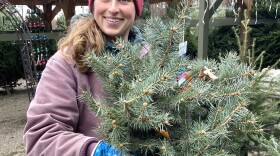There’s lots to do in the garden, but you can take one thing off your list. Although it won’t necessarily be neat and tidy, gardeners and ecologists recommend leaving perennial plants – including stalks and canes – as is until spring.
Birds benefit from the seed heads, and insects and small creatures use stalks and leaf litter for over-wintering.
Emma Erler, host of Homegrown NH and lead horticulturist with Kirkwood Gardens at Squam Lakes Natural Science Center, says she prioritizes cutting back anything diseased, keeping an eye on peonies or phlox that are prone to powdery mildew.
“I cut those down and keep those out of my compost pile, because it doesn’t get hot enough to kill the fungi and disease.” she says. “I want to limit that as much as possible. So I either burn those or bring them to the transfer station.”
“For birds and insects, I leave as many native plants standing as possible,” she says. “Coneflowers and black-eyed susans have really nice seed heads. And ornamental grasses have seeds that are eaten by wildlife. And they're really beautiful in winter, swaying in the snow and ice.”
If you leave seed heads for the birds, grab a few seeds for yourself as well.
“I have a lot of fun starting perennial plants from seed, particularly natives,” Erler says. “I will collect as much seed as I can in the fall. On a dry day when those seed heads are totally ripened, meaning the flowers have gone by quite a while ago. Then I'll keep that seed in a cool, dry place until I'm ready to start it the next season, either indoors or directly in the garden.”
Fall is also a time that some perennials, especially peonies, prefer to be planted, so roots can get established without the heat of summer.
It’s also a good time to take the opportunity to double the number of perennials in your garden by dividing them.
“Lots of things can be divided in the fall,” Erler says. “Think your irises, daylilies, and hostas.”
See you in the garden!
Homegrown NH is a collaboration between Squam Lakes Natural Science Center and NHPR.










